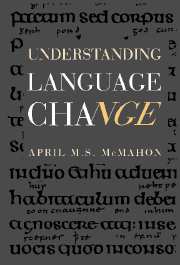Book contents
- Frontmatter
- Contents
- Preface and acknowledgements
- 1 Introduction
- 2 Three views of sound change
- 3 Sound change 2: the implementation problem
- 4 Morphological change
- 5 Syntactic change 1: the Transparency Principle
- 6 Word order change and grammaticalisation: language change and general laws
- 7 Semantic and lexical change
- 8 Language contact
- 9 Linguistic variation
- 10 Pidgins and Creoles
- 11 Language death
- 12 Linguistic evolution?
- Bibliography
- Index
6 - Word order change and grammaticalisation: language change and general laws
Published online by Cambridge University Press: 05 June 2012
- Frontmatter
- Contents
- Preface and acknowledgements
- 1 Introduction
- 2 Three views of sound change
- 3 Sound change 2: the implementation problem
- 4 Morphological change
- 5 Syntactic change 1: the Transparency Principle
- 6 Word order change and grammaticalisation: language change and general laws
- 7 Semantic and lexical change
- 8 Language contact
- 9 Linguistic variation
- 10 Pidgins and Creoles
- 11 Language death
- 12 Linguistic evolution?
- Bibliography
- Index
Summary
Introduction
In the last chapter, we explored the insights into syntactic change which might be gained by operating within the confines of a formal model of grammar. Here, we shall consider syntactic change as part of an investigation into whether there are general laws which languages must obey, and whether such laws might somehow compel language-internal changes to proceed in a particular direction.
The observation of directionality in syntactic (and other) change is not new, and has been discussed under various labels in the literature. One of the most famous is probably Sapir's (1921: 150) suggestion that ‘Language moves down time in a current of its own making. It has a drift.’ Sapir argues that, although individual variation is random, drift in a language is directional, and operates by the unconscious selection of variants which change the language in a particular, cumulative way. Each individual change will therefore be part of a series, being prefigured by earlier developments which it continues, and providing an input for subsequent changes. Sapir isolates three particular morphosyntactic drifts in English, which might well be expected to recur cross-linguistically: these are the levelling of case distinctions; the fixing of word order; and the tendency towards invariable words.
There seem to be two ways of making sense of the rather mystical concept of drift. The first is to assume an evolutionary framework – and indeed Malkiel, in a detailed survey of Sapir's notion of drift and its various interpretations, defines drift as ‘a single, isolated, undisturbed evolutionary strain or streak’ (1981: 566).
Information
- Type
- Chapter
- Information
- Understanding Language Change , pp. 138 - 173Publisher: Cambridge University PressPrint publication year: 1994
